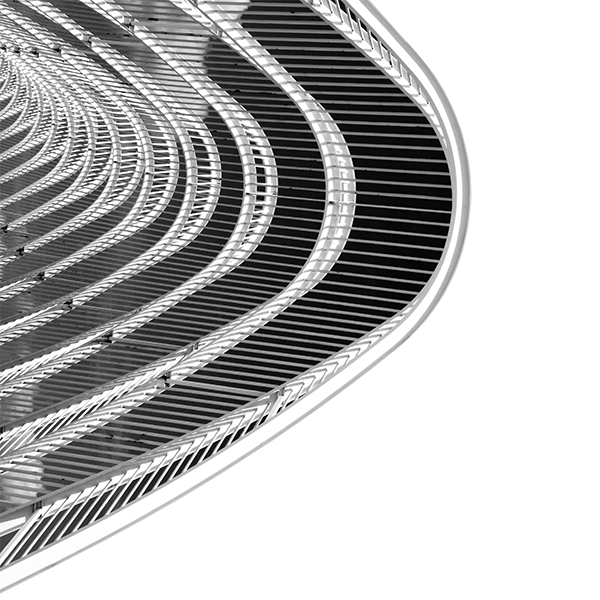Direct Effects
Most modern aircraft are constructed with composite materials because of their weight advantage over metals. However, composite materials such as carbon fiber (CFC) are generally less conductive than metals such as aluminum. Because of this, the potential for damage at lightning attachment points is usually higher on aircraft with composite surfaces than those with metal surfaces. Figure 1[1] shows an example of lightning attachment damage to the surface of a composite airplane. Qualitatively similar damage can be expected on any composite vehicle that undergoes a lightning strike. This type of damage, directly from the result of lightning strike, is referred to as direct effects.
To help protect against lightning damage, composite aircraft often apply conductive treatments to the vehicle’s surface. A good conductive treatment reduces the risk for burn-through, delamination and other structural damages that may occur. From a design standpoint, a conductive treatment must be lightweight, relatively inexpensive to apply, and require minimal expense to maintain. Otherwise, the advantage of using composite surfaces is negated.
There are many types of conductive treatments for composite skins available. While the use of expanded metal foils is common, many other attractive options are now market ready or are in an advanced development stage. Whichever option provides adequate lightning protection with minimal initial and operational cost is the right option for the user. A description is provided below for several conductive treatments (technology readiness in parentheses), and Table 1 summarizes some information about each option.
- Expanded Metal Foils (mature) – Are expanded, perforated foils made of one piece of metal. They can be designed with a variety of thicknesses and other properties. A lightweight and relatively common choice.
- Advantages: Effective, lightweight protection for all zones
- Disadvantage: May be less initial cost effective than other options
- Solid Metal Foils (mature) – Are similar to the expanded metal foils, but consist of a single unperforated sheet of foil. The lack of perforation results in more weight per square foot of application.
- Advantages: Highly effective protection for all zones
- Disadvantage: Extra weight and higher initial cost
- Graphene (emerging) – Nanotube sheets that can be applied directly to the surface of a composite and carry up to 100 times more current density than expanded metal foils.
- Advantage: Lightweight and extremely conductive per sheet
- Disadvantage: High impedance between sheets may reduce effectiveness
- Ultra-conductive film and coatings (moderately mature) – Highly conductive epoxy film that utilizes non-nano, commercial materials to protect composite aircraft structures from a direct lightning strike.
- Advantage: Half of the weight of conventional expanded foils
- Disadvantage: Application costs may be higher than other options, and lower conductivity than expanded foils
- Arc or flame sprayed metals (legacy) – These are solid metal coatings applied by spraying molten metal onto the surface.
- Advantages: Excellent coverage for all strike zones and ability to cover all shapes
- Disadvantages: Cost of application and extra weight
- Woven wire fabrics (legacy) – Metallic fabrics woven from small diameter wires of aluminum or copper.
- Advantages: Light weight with effective coverage for all strike zones
- Disadvantages: Difficult to drape over compound curves
- Aluminized Fiberglass (legacy) – Glass fibers are woven with aluminum into fabrics with significant electrical conductivity. The glass provides a heat sink which allows the aluminum to carry twice the current load that it could without the glass. This option tends to result in more extensive damage than laminates protected with woven wire fabrics or expanded metal foils.
- Conductive Paints (legacy) – Paints with conductive particles added provide marginal protection against DE of lightning. The virtue of this option is that it can be applied post-production. However, it must last the life of the vehicle or be reapplied. It is much less effective than some of the other options.
- Interwoven wire (legacy) – This method protects CFC laminates by adding fine metal wires into the outer ply of a CFC skin. Aluminum is the most commonly used option.
- Advantage: Lightest weight option, ease of manufacture, maintenance and repair
- Disadvantage: Potential for corrosion when subjected to moisture.
Table 1. Summary of common conductive treatments for composites
Type of treatment | Example Trade Name | Technology Readiness and Popularity | Typical Installed Weight (psf) |
Expanded Metal Foils | Dexmet, Astrostrike, Aero Mesh by Niles | Mature, Popular, State-of-the-art solution | .03-0.075 |
Solid Metal Foils | Mature, Popular, State-of-the-art solution | 0.1 | |
Graphene and Nanotubes | Emerging, Research Interest | Under investigation | |
Conductive Expoy Film | LORD UltraConductive | Moderate, High Interest in Commercial Aviation | 0.029 |
Flame sprayed metals | Legacy Solution | 0.08 | |
Woven wire fabrics | Legacy Solution | 0.03 – 0.05 | |
Aluminized fiberglass | Legacy Solution | ||
Nano-metal Coated Fibers | Conductive Composites | Emerging, Research Interest | |
Conductive Paints | Legacy Solution | 8 | |
Interwoven Wire | Legacy Solution | 0.024 |
[1] Lightning Strikes: Protection, Inspection and Repair, Sweers, Birch and Gokcen, www.boeing.com


